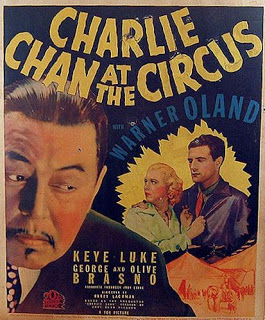
Even as a child I hated the circus. I still do. The animals in cages, the whips, the high aerial acts, the crazy side shows like the Lady with a Beard - so I usually even avoid watching films about circuses. I made an exception for this one because it is Charlie Chan. It is reasonably entertaining but is also on the downward slope with too much silly comedy. In one scene Lee Chan (Keye Luke) follows a suspect while dressed as a woman with a baby carriage and inside is a midget smoking a cigar. In another he gets locked in a monkey cage.
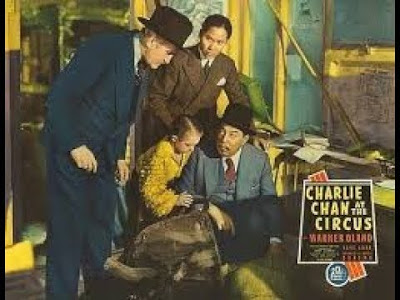
Charlie Chan and his entire family of twelve children are on a vacation and are invited to come see the circus (filmed in a real circus). Imagine going on vacation with twelve children. Yikes. Murder follows Charlie like a five o'clock shadow - and the man he has come to see is found dead in a locked trailer. The main suspect is a gorilla who had escaped. Lee Chan is on hand whether to help or hurt is always debatable but he falls like a brick for the Oriental Human Knot who can tie herself up in various pretzel like positions - you can hardly blame a man for that. Su Toy is played by an actress born in Japan named Toshia Mori who has some other credits around that period and shows up in Charlie Chan on Broadway (her last credited film).
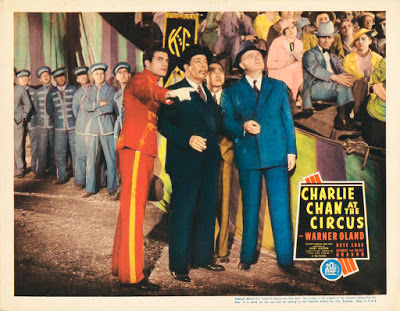
The film has a small musical number though not quite as interesting as The Apache Dance in Charlie Chan in Paris. But it is performed by George and Olive Brasno, a well-known brother-sister vaudeville act at the time. What makes them unusual I expect is that they are Little People. They had lengthy careers but they also both turned down the chance to be Munchkins in the Wizard of Oz because they were making so much more money on the stage. George died in 1982 and Olive in 1988.
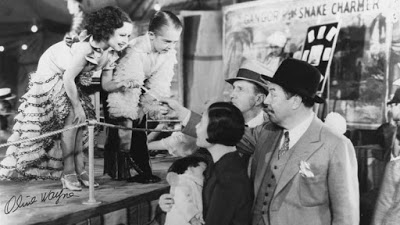
Warner Oland was an alcoholic and at times it was worse than others. Sometimes he would just disappear for days and the production would have to be held up - on a B film that was painful. Keye Luke talks of having lunch with Oland - who he had great respect for - and saying Charlie would pull out a thermos of "tea" every day. His drinking problem was getting worse and during the filming of this, they hired a nurse to be with him and make sure he didn't drink. You can see it a bit in his face - bloated and blank in certain scenes - it was to kill him within a few years.
Charlie Chan at the Race Track (1936) – 5.5
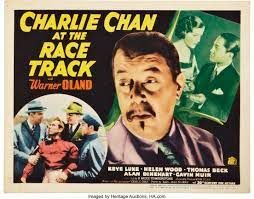
This like most of the Chan films is a bite sized offering and has its charms. From 1936 (there were four Charlie Chan films made in 1936), both Charlie Chan at the Circus and Charlie Chan at the Race Track are beginning to show a little wear and tear with budgets and scripts that feel a bit less imaginative than previously. Warner Oland stars in both but his off-screen drinking is beginning to take a toll on his life, marriage and ability to show up for work. He sometimes disappears for days at a time. In one scene in Race Track he apparently had to be held up by the actors around him. Earlier in his portrayals of Charlie, Warner had found that he needed a few hits of the bottle to get the rhythm and cadence of the detective’s odd speech patterns down, but now it was difficult not to slur the aphorisms that were Charlie’s trademark.

Keye Luke appears in both films as Lee Chan, the modern hip skirt chasing Son #1. Luke was to be in 10 Charlie Chan films – the first eight with Oland but curiously he came back years later in 1948 to be in the final two Charlie Chan films with Roland Winter. Keye Luke had a long career and one of the few that any Asian-American had in those days. He had been an architecture student at the University of Washington and later helped paint the murals at the famous Grauman Chinese Theater. Then in 1935 he had his debut in Charlie Chan in Paris. In an oddity Keye is almost in another Charlie Chan film – but with the illness of Oland the planned film Charlie Chan at the Ringside was turned into Mr. Moto’s Gamble in 1938 starring Peter Lorre and Luke appears in it as Lee Chan. As an aside, co-incidentally Mr. Moto was created thanks to Charlie Chan. When Earl Derr Biggers the creator of Charlie Chan died unexpectedly in 1933, the publishers wanted another Asian detective character and so asked John Marquand to come up with one and so he delivered Mr. Moto. Luke went on to be the first Kato in two Green Hornet serials in 1940. Later in 1972 he was the voice of Charlie Chan in an animated TV show called The Amazing Chan and the Chan Clan. But to modern audiences he is likely most well-known as Master Po in the Kung Fu series. He passed away in 1991 working until the end.

In this one a crooked racing syndicate is fixing races through some complicated means like darts and switching horses - and murder. Chan who is in Hawaii suspects murder on board a liner carrying horses and the owners - and boards the ship for the rest of the trip to L.A. A few of Chan's films have him aboard a liner - the lap of luxury in those days. His son, Lee Chan comes aboard as well disguised as a cabin boy with his pidgin English in place. The film also darts down that sad path of another lazy yessuh nosuh black character as they did in Charlie Chaplin in Egypt. This time he is played by John Henry Allen, who has credits in a few other films but I can't find out much about him otherwise.
Charlie Chan at the Opera (1936) – 6.5
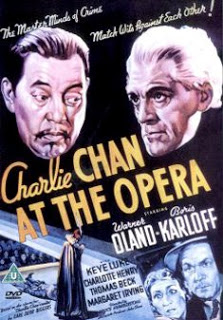
The opening credits have above the title “Warner Oland vs. Boris Karloff”. At the Opera is a surprising rebound for the film series with a fast moving plot that at times feels as much like The Marx Brothers A Night at the Opera as a crime mystery and has a terrific cast with the great supporting actor William Demarest (in a million films and the TV series My Three Sons) as a flat-footed cop and Boris Karloff as a mad opera singer who has escaped from a mental institution for revenge. We meet Karloff on a dark and rainy night at the Rockland State Sanitarium as he sits alone playing the piano and singing an aria. He spots a newspaper which has a story about a female opera star coming to Los Angeles. This sets him off as he says “Now I remember” and he escapes with that mad Karloff look on his face. He goes to the opera house and people begin being murdered. Charlie Chan happens to be there after his Race Track Murder Case that is referred to with tickets to take the boat to Honolulu that night. He has to work fast but he has his son (Keye Luke) at his side. Only one reference to Karloff in the film that I got when the stage manager says “I'm stage manager here and this opera's going on tonight even if Frankenstein walks in.” And he did.
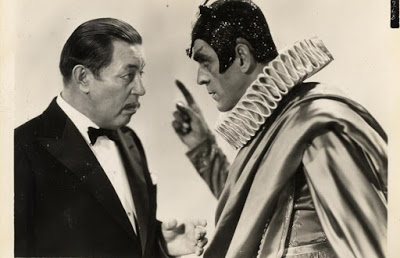
But for me the most intriguing aspect of the film is that the opera music was specifically written for the film by none other than Oscar Levant. Who was Oscar Levant you might ask? He was one of the great characters and wits of Hollywood in that period as well as a first class musician and composer. He is best-known probably as Gene Kelly’s friend in An American in Paris and for appearing in The Bandwagon with Fred Astaire. Levant is the guy who famously said "I knew Doris Day before she became a virgin." and of DiMaggio’s divorce from Marilyn Monroe: "No man can excel at two national pastimes."

One negative aspect of the film are a few racist things that come out of Demarest’s mouth. His prejudice against Chinese is apparent right away by his calling Chan Chop Suey and Egg Foo Young. But by the end he is thanking Chan for solving the crime by saying he is like Chop Suey, “a mystery but a swell dish”.
Charlie Chan at the Olympics (1937) – 6.5
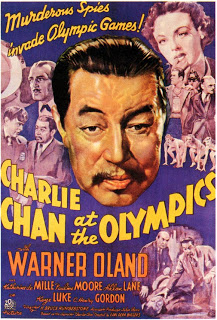
One of the better Chan films, Charlie Chan at the Olympics feels very odd now as it of course takes place in Berlin in 1936 and the Germans are the good guys! By 1937 when the film was released Europe was already on the edge of war and Germany was clearly not one of the good guys - but this might have been done in order to be shown in Germany which was a large market for American films. But people knew war was coming. At one point one of the villains says to Charlie - here we have the struggle of nations in sports but soon it will be at much more - just go home to America and stay out of the way. Of course, Chan doesn't even when son number one's life is at risk. Better to lose life, than lose face he says.
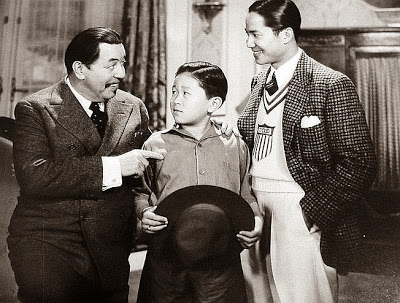

Charlie Chan on Broadway (1937) – 6.0
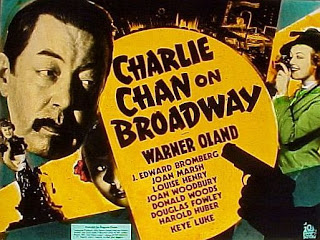
By this film Warner Oland's problems were getting worse due to his drinking. His wife had left him and he was living with a friend. He often had to do multiple takes just to get one line correct. The filmmakers had increasingly given more time to other actors to lessen the burden on Oland. In particular, Keye Luke was getting more time as he had struck a chord with the audience of this young, smiling, energetic Chinese man actually being played by a young, energetic Chinese man. His warm and affectionate relationship with his father, Charlie Chan, was one of the strengths of the series ever since he showed up in Charlie Chan in Paris as Charlie throws one bit of wisdom after another at his son. This reflected their off screen relationship in which the two had become very good friends and spent time together. The films were still quite popular and profitable and Oland was a star. Luke says they could not go anywhere without fans surrounding them and that Oland loved the attention - but he could not stay away from the bottle and hid them from a nurse the studio appointed to keep him from drinking.

The Chan's are travelling again. Back from the 1936 Berlin Olympics we assume where the son won a medal for swimming. For a Honolulu police detective Charlie doesn't spend much time at home. This was just a device the studio used to keep the films varied - not that any of them were actually shot anywhere but in Hollywood. They are coming from Europe on a liner when they meet a woman stuck in her bathroom and screaming for help. She turns out to be Billie Bronson (Louise Henry), a mob moll with a diary full of secrets coming back from exile in Europe ready to sell it for cash. She may as well have victim stamped on her forehead and sure enough she is murdered at the Hottentot Club on Camera Night, when the patrons can bring their camera and take photos of all the dancers - so we get the unseemly sight of men in tuxedoes down on the floor trying to shoot up the dancers skirts. The Chans are on the scene along with a loudmouthed fast talking NYC cop played by Harold Huber.

A few other actors from past Chan films are in it as well - Joan Woodbury dances in the club as she had in Charlie Chan in Shanghai, the Japanese actress Toshia Mori is back after being the Human Pretzel in Charlie Chan at the Circus, Donald Woods had been in the lost Chan film, Charlie Chan's Courage and played Perry Mason this same year and a few other B villains - Leon Ames, Marc Lawrence and tough guy Doulas Fowley. Like most of these Chan mysteries there is a busload of suspects and everyone of them looks guilty except the one who did it.
Charlie Chan at Monte Carlo (1938) – 6.0

At the end of the film Charlie Chan and Number 1 son Lee get into a taxi and comically drive away after solving one more murder case. It was to be our last sight of these two actors together in those roles. Warner Oland was to die before his next Charlie Chan film was finished and Keye Luke had no desire to continue playing his character after Oland died - there is only one Charlie Chan for me, he said of his friend who he called Pops. Oland had played Chan in 16 films - four of them now lost. By the end those were the only films he was making. Not only did the audience identify him as Chan, but so did he. He loved the character to such a degree that he visited Shanghai with great fanfare and talked of this being his homeland. He even began talking in what were termed Chanograms - those pithy aphorisms that either delight modern day audiences or outrage them.

These days Oland is often treated with sneers and ridicule for playing the role of an Asian man in so many films and his portrayal of a humble, quiet traditional Chinese man in America. I think it is an unfair accusation - now you can certainly criticize the Hollywood practice of Yellow Face but at the time it was so common that no one thought twice about it (except I expect Asians!). And Oland always gave Chan a sense of dignity and he is always the smartest guy in the room making fools of all the white people around him - but doing so simply with facts and good manners. And with only a few exceptions he is treated with complete respect - to those who don't, he pokes fun at them that makes his point. The relationship between him and his large family and in particular with Lee is one of the most sympathetic and loving in film.

Oland was born in Sweden in 1880 and came to America when he was 13. He made his stage debut in the Sarah Bernhardt Company and began producing his own plays in the Hudson Theater. They were not successes and he tried his luck in film with Jewels of Madonna in 1909 with Theda Bara. He continued to work often in the silent era and with his Slavic looks he played all sorts of ethnic types - Russian, Turks, Indians, Hispanics and Asians many times. He was able to portray Asians with very little make-up - just a slight pulling back of his eyes. Pictures of him as him vs as an Asian were not so different. Unless it was Fu Manchu of course! He played Fu Manchu a few times. His first Chan film was in 1931.

By 1936 he was deep into drink. He got married to a woman ten years older than him and though that helped for a while he slid back. He was making good money for the time - for his first Chan film he received a salary of $10,000 per film - then $20,000 and finally $30,000. It was a very popular series and he was much loved. But the drink was taking its toll. He would disappear, he would be found in a drunken stupor on the set, a nurse was hired to stop him from drinking but he slyly hid bottles of it, he had to actually be held up in certain scenes and retake after retake had to be done. After this film he began filming Charlie Chan at the Ringside in 1938 but he was really out of it - he had been found wandering Los Angeles at night not knowing who he was. He quit the film - was suspended - dried out and signed a new contract for three more films but before beginning the new film he sailed to Sweden to visit home where he passed away.

His last film is a good one though at 75 minutes it is longer than normal and it feels it at times. Charlie is in Monte Carlo at the casino when the police inspector played by Herbert Huber introduces himself (he had been the police captain in the previous film, Charlie Chan on Broadway) - and introduces him to the characters who will play a role in the ensuing murders. A million dollars in bonds are stolen and a few murders tag along with them. Chan and son had been going to Paris to see Lee's painting in an exhibition (Keye Luke was a fine painter in fact), but they stick around for the murder. Among the suspects is Virginia Field who every time I come across her I wonder why she didn't become a star - just a knockout. Chan gathers them all in one room and makes his denouement. And then goodbye Warner Oland but Chan was to be back with a new actor in the same year, Charlie Chan in Honolulu. The film that had begun as the next Chan film was turned into a Mr. Moto film Mr. Moto's Gamble which has Keye Luke in it as Lee Chan.
